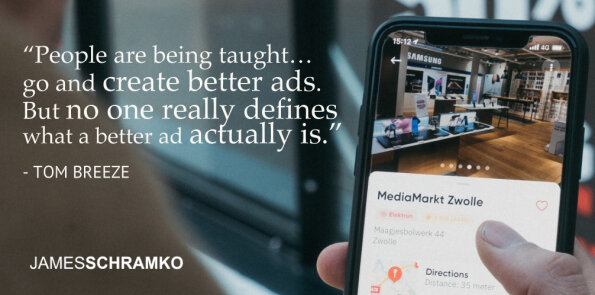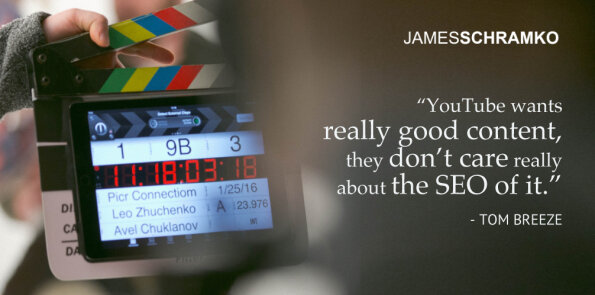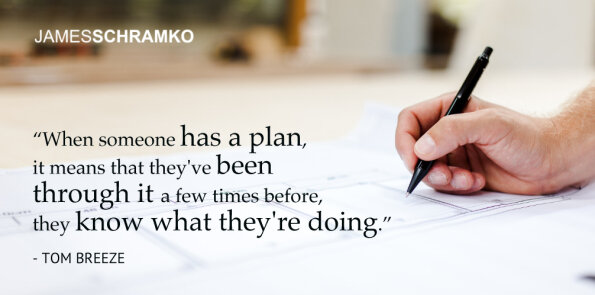Podcast: Download (Duration: 1:04:19 — 59.7MB)
Get Notified Of Future Episodes Apple Podcasts | Spotify | Amazon Music | Android | Blubrry | Gaana | TuneIn | Deezer | Anghami | RSS | More
A lot of what marketers expect to work on YouTube doesn’t. Viewability’s Tom Breeze has achieved great success for clients on the platform, and unpacks what he knows here.
He and James discuss what makes YouTube ads different from ads on Facebook.
They talk about clickthrough rate and cost of advertising, and how they’re related on YouTube.
And Tom shares his newly updated framework for creating really good content.
Table of contents
1. Why many people find YouTube difficult
2. How user intent influences YouTube ads
3. The CTR-CPM connection
4. Does it help to disqualify people?
5. Longer ad plus more education
6. Can you control the frequency of ads?
7. When you’re too aggressive with your marketing…
8. How far should you push?
9. A combination of the right things
10. What really good content can achieve
11. The tool that can assess YouTube content
12. A handy formula for good content
-
a. A – Aim
b. D – Difficulties
c. U – Undertaking
d. C – Credibility
e. A – Action plan
f. T – Tweak
g. E – Emergence
h. S – Stack
Why many people find YouTube difficult
Tom and his team have had a massive breakthrough in the way they approach YouTube advertising, based on data and trends they’ve encountered in the line of work.
One thing hasn’t changed – YouTube is still a place where people want good content. Users want good video and helpful video.
The thinking on most platforms, however, is you make great ad content that engages people, and then lures them away to your site. This doesn’t work on YouTube, and that’s what trips marketers up.
People are being taught, go and get better at copy, go and create better ads. But no one really defines what a better ad actually is.
On YouTube, a better ad is not about getting people to click to your site, and that flies in the face of everything ad makers know about direct response.
How user intent influences YouTube ads
Does it have to do with the intent people have when they’re on YouTube, wonders James? Many users, himself included, go onto YouTube to learn stuff – does YouTube look to harness that intent and then develop it further?
People on YouTube are mainly looking to be educated or to be entertained, says Tom. YouTube knows that, and they have always known the platform will be built by the content creators.
So they reward content creators with revenue. Mr. Beast, for instance, made 52 million or more last year.
The more money content creators make, the better content they tend to create, so it’s a good relationship between the content creator and YouTube. The third wheel, however, is the advertiser, who pays to have their ads on the platform, and who has their own intentions.
Advertisers want people to come off the site and buy their products. And YouTube naturally doesn’t want that.
The CTR-CPM connection
This is where YouTube differs from Facebook. On Facebook, the better the ad experience, the higher the clickthrough rates (CTR), the more website conversions, and the lower the cost of running your ads (CPM).
On YouTube, it’s the opposite – trending data has shown Tom and his team that as clickthrough rate increases, CPM increases. And not just by a nudge – CPM can triple or quadruple quite easily.
They could have ridiculously good ads, a great website, and sky-high CTR, but the CPM would be prohibitive to good results.
What they needed was less people clicking, but for almost every click to turn into a purchase. Lower CTR, lower CPM, but wildly profitable campaigns that they could then scale.
Does it help to disqualify people?
In the direct response world, says James, they’d do things like disqualify bad fit prospects, with a long-form sales page, for instance. Would Tom do something similar, maybe a longer video or a notice somewhere of who it is not for?
You can definitely do that, says Tom. Some people, though, when told something isn’t for them, will click out of curiosity.
Like Eve and the apple, says James.
Precisely, Tom says. One thing you can do in your ad, however, is mention the price early on and disqualify those who can’t or won’t pay it.
That’s a huge tip, James says. He himself mentions his prices up front on all his offers, and does demos and podcasts and case studies and answers emails, all to avoid getting the wrong-fit client.
Longer ad plus more education
Another approach Tom loves to take is to create a slightly longer ad that offers more education and valuable advice.
They’re there to be educated, says James, so educate them in your ad. He still sees something similar in magazines – ads that read like a journalistic piece of content.
You can do all that relationship building, Tom says. Everything you’ll be in your customer journey can be put into your actual video and run as an ad.
And people will say, if you have longer ads on YouTube, you get penalized, and it costs you more money. That is true, but it’s nowhere near the cost of a really high clickthrough rate.
Can you control the frequency of ads?
James has a random question. There are ads he’s seen, the same material, over and over again whenever he’s on YouTube.
Is there any way you can control the frequency of particular ads? And is it good or bad that these people are on so often?
As a user, says Tom, you can’t control how frequently people appear to you. And he’s not sure either whether you can report them as you can on Facebook.
As an advertiser, though, you can control the frequency, right?
You can, Tom says.
It’s the story, however, of any ad platform, that crappy ads are ruining the experience when you’d rather just enjoy the content. And that’s what YouTube is going towards.
People who blitz their audience with the same ad over and over pay for it with fast ad fatigue, and eventually end up paying money that doesn’t need to paid.
When you’re too aggressive with your marketing…
It could negatively impact the brand in the long run, too, says Tom. Certainly there are people he’ll never buy from, just because they bombard him with ads.
The funny thing is some people will push hard to get a sale at any cost. And they might have a good run of 45 to 90 days, after which performance drops off for the long term, not least because people are simply sick of them.
How far should you push?
So how do you know how much to ramp up, asks James?
It’s a difficult balance, Tom says, and it depends on the approach you take.
With a live event you can push hard. With a yearly event, you can push harder and chalk it up to branding for the next year.
You’ll want to do do a lot of relationship building for the rest of the year, though, to be able to then advertise big again. Tom doesn’t really work with that kind of business – the campaigns are very difficult to run.
It’s far easier to find the cadence of, Alright, we’re at this much spend per day, bringing in this much profit – we’ll nudge it up. And if results start dropping, pare back a bit for consistency.
It’s a matter normally of finding the maximum point which is consistent year round, and then edging it by trying to create better content that adds better, like website and things like that.
YouTube advertising is the same with anything. If you push too hard, you’re going to have consequences as a result. And those consequences are never very positive.
A combination of the right things
Tom and his team do what they do with great success, by considering what YouTube wants and what its users want. Which is not to say it’s been easy.
To address that challenge, they built software to identify how to create content in the very best way, because most people are on YouTube for the content. And the ad structure they tend to push for these days is informative; entertainment is great, but not a prerequisite.
Good ad content works for direct response activity; you can run it as long form content, it gives good information, and it’s a good sales pitch that runs as a YouTube ad.
And you can tweak it ever so slightly to make it a great organic piece of content as well. Then you have the best of both worlds – it’s a video ad you can promote to generate your customers profitably, and it fits with the ecosystem, and you can release it as an organic video.
Then you have this ability to get huge amounts of views to video content that’s very good quality and people love. And YouTube are loving you because you’ve got a video that is an organic video and an ad, and it grows very quickly, and it builds the brand – that’s what YouTube are looking for.
YouTube want brand advertisers whose ads don’t get many clicks, because then they keep everyone on the platform. So create great content that has a small number of clicks, but mostly turns people into customers; build your brand awareness, build my fame as a personal brand, if you want to.
What really good content can achieve
It doesn’t take two years of posting twice a week to crack YouTube, says Tom. You can probably create three to 10 videos, work out the right content that works really well for your customers, and promote that.
Get the foundation set to begin with – learn what it is your customers and what YouTube love. And when you get that in place, then you can scale on the platform with a lot more consistency.
So hang on a minute, says James, can we just take our very best content that’s organic, and turn it into an ad?
Yes, surprisingly, Tom says. Even if it doesn’t have a call to action.
Tom has worked with channel owners who were good at content, but who would not profess to be good marketers. They started promoting some of their organic content, putting a bit of ad spend behind it.
The priority was to grow a channel, and as an afterthought they put tracking on it. They ran a campaign to a website that wasn’t well optimized, that had just different products in different places.
The ROAS was about 3x to 4x on their first campaign. This would be new people finding the channel through the promoted videos, and loving the content so much they would go on their own journey to find out where they could buy something.
It was effectively doing two things at once – growing a channel faster than it had ever grown, and making it profitable. That’s why Tom and his team have shifted their attention to mixing direct response with organic and promoting it.
The tool that can assess YouTube content
Tom and co. are getting much more data, too, because they’ve built software to understand exactly what content gets high retention, gets really good social engagement, and gets people clicking to a site. And then if can find out what content is already working, if it’s good quality, they can promote that immediately, even if the call to action is not great.
And the insights from the software can tell them how to improve that content as well.
Tom’s software, Bidurk, was built to address a lack of tools that could tell you how to create good content. James let him test it on his own YouTube channel, which then had five and a half thousand subscribers and about 2000 videos.
The software identified which of James’s videos were the best, which were the worst, and how things could be improved.
They renamed the channel from SuperFastBusiness to James Schramko Shorts, and are now putting only short videos on it. They changed some of the video titles to have a more positive slant and more relevance, and made better thumbnails.
The videos have gone from getting 30 or 50 views on average to 1,500 plus views.
The software is like an x-ray, says James.
Most tools out there, says Tom, will split test thumbnails or tell you what to put in titles or SEO the metadata of a video. That’s great, he says, but he’s just going to create ridiculously good content – YouTube want really good content, they don’t care really about the SEO of it.
The best part? If you go to bidurk.com, Tom and his crew are currently doing free X-rays. You can log in and connect your account – they don’t need access at all. And then you run it, and they’ll jump on a call with you to talk through the findings.
A handy formula for good content
While Tom is on, says James, it would be worth asking him the formula for making good content. They may have covered it before, but it’s gone through a couple of revisions.
ADUCATE is now ADUCATES, says Tom, which breaks down as follows:
A – Aim: What do your customers really want? Speak to that quickly, it’s important. Skip the long-winded intros. The faster you can get into your content, the more attention you will have.
D – Difficulties: What is standing in the way? What are the problems your customer’s currently having? What’s frustrating them? What’s the negative impacts of all that? Align properly with your audience and they will learn to trust you.
U – Undertaking: You want to explain to your customer at some point the reason your brand exists, why you do what you do. They want to have a sense of belonging and know that you have values. And whatever your values are, you want to be clear about what you stand for and against, because people want to align with that.
C – Credibility: Credibility is, this is what I’ve done. This is why I am qualified to go on this journey, to try and fix this problem that’s never been fixed before. Here’s a bit of my background.
A – Action plan: This is your methodology, your unique method of doing things. You want to make sure all the education you’ve been teaching people fits into a model of some sort, a system. When someone has a plan, it means that they’ve been through it a few times before, they know what they’re doing. And again, it feeds into that credibility.
T – Tweak: What you’re going to say here is, This action plan that we developed, it works, it’s really efficient, but it had a slight drawback. It’s the damaging admission. And you talk about what you did to fix it.
E – Emergence: This is where you build up the second wave of credibility, by talking about the success you’ve had as a result of fixing your method.
S – Stack: Here you want to tell people, here’s what it is, here’s the price of it. It’s sort of disqualifying people just by the nature of the price of it. And then you want to discuss any bonuses or guarantees included, but not in a full-blown sales pitch.
Then on your website, you’re selling at that point, with a sales page. It doesn’t need to be too long, because you’ve done most of the selling on YouTube, but now you know the only people clicking at that point know the price point, have built a relationship with you, know your value is really strong, that you’ve already provided in the video, and this next sale is a continuation of the train they’ve already had with you.
The ADUCATES model is a very good starting point. Tweak it to fit your personality, and it doesn’t have to be done at exactly the same order every time.
You just want to create the best content you can, put a good sales pitch together at the end of it. And then you get the best of both worlds.
This is where you drop the mic, says James.
Leverage the content, coaching and community inside the James Schramko membership
Liked the show? Leave us a review on iTunes













Leave a Reply